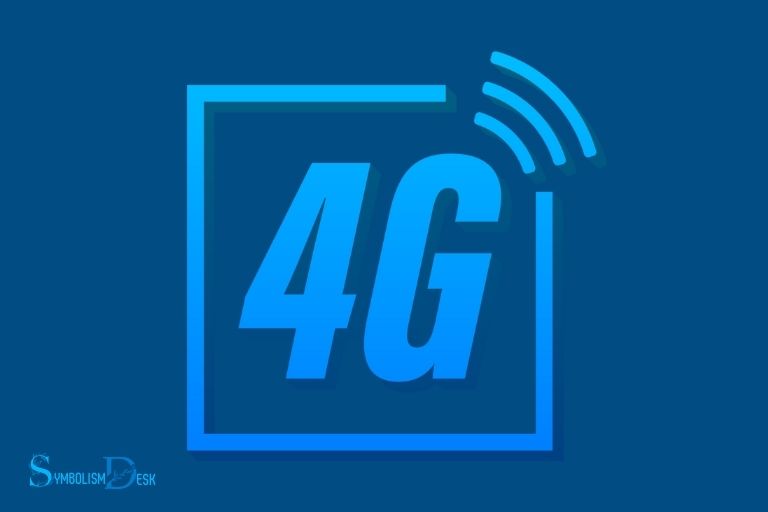What Does the 4G Symbol Mean? Faster Internet Speeds!
The 4G symbol means that your device is connected to a 4th generation cellular network, offering faster internet speeds, smoother video streaming, and improved overall connectivity.
4G, short for 4th generation, is a mobile communication standard that provides enhanced performance compared to its predecessor, 3G.
It uses advanced technologies to provide a better user experience through faster data transmission, higher-quality voice calls, and reliable connectivity even in densely populated areas.
As a significant upgrade from 3G, 4G networks have become the standard for modern mobile communication, making it easier for users to stay connected and access various online services.
By displaying the 4G symbol on your device, it indicates that you are benefiting from faster and more reliable connectivity, ultimately enhancing your overall mobile experience.
Understanding the 4G Symbol: Detailed Breakdown
| 4G Symbol | Meaning |
|---|---|
| 4G | Fourth Generation of Mobile Networks |
| LTE | Long-Term Evolution, a type of 4G |
| HSPA+ | High-Speed Packet Access, another type of 4G |
| Mobile Internet | The use of 4G for internet connectivity on mobile devices |
| Faster Speeds | Improved data transfer rates compared to previous generations (2G, 3G) |
| Improved Latency | Reduced time delay in data transfer, better for real-time applications |
| Video Streaming | 4G enables smoother and higher quality video streaming on mobile devices |
| Voice over LTE (VoLTE) | High-quality voice calls using 4G technology |
Key Takeaway

Five Facts About: The 4G Symbol
Understanding The 4G Symbol For Mobile Networks
Definition Of The 4G Symbol And How It Came About
4g, also known as fourth generation, is the latest mobile network technology used by smartphones, tablets, and other mobile devices.
The 4g symbol on your mobile device indicates that you are connected to a high-speed mobile internet connection. The 4G symbol on your mobile device indicates that you are connected to a high-speed mobile internet connection. This allows you to browse the web, stream videos, and use apps seamlessly with minimal delays. For iPhone users, understanding the e symbol meaning on iPhone and other network indicators can be helpful in determining the quality and speed of their current connection.
It is an important technological advancement in mobile networks, allowing faster and seamless data transfer.
The 4g symbol was introduced in 2008 by the international telecommunications union (itu), a un agency that sets global communication standards.
The itu defined the specifications for 4g technology, such as minimum data transfer rates and network architecture.
Initially, 4g networks were designed to provide faster data transfer and improved multimedia support to mobile devices.
However, the technology has evolved over time, and newer variants of 4g, such as 4g lte and 4g lte-a, provide even faster data transfer speeds.
Explanation Of The Impact Of The 4G Symbol On Mobile Networks
The 4g symbol has had a significant impact on mobile networks.
Here are some ways in which it has revolutionized mobile connectivity:
- Faster data transfer: The 4g symbol means that you can enjoy faster downloads, smoother video streaming, and faster web browsing. Mobile networks have become more efficient, allowing users to transfer data at speeds of up to ten times faster than 3g.
- Improved network capacity: 4g technology allows mobile networks to handle more users, better quality services, and greater coverage. Higher bandwidths and more efficient network architecture result in fewer dropped calls and faster downloads.
- Increased innovation in mobile devices: The introduction of 4g has led to the development of more advanced mobile devices. Smartphones, tablets, and other mobile devices are now designed to take full advantage of 4g technology.
- Enhanced user experience: With 4g, mobile internet has become more reliable and faster, making it easier to stay connected and access information on the go. The 4g symbol on your mobile device indicates that you can enjoy high-speed internet and improved user experience.
The 4g symbol is a key indicator of high-speed mobile network connectivity that has transformed the way we use mobile devices.
Its introduction has resulted in faster data transfer speeds, better network capacity, greater innovation in mobile devices, and an overall enhanced user experience.
What 4G Symbol Stands For
What does the 4g symbol mean? If you’ve seen a phone’s screen showing four bars with the letter ‘g’ next to them, then you might be wondering what the mysterious 4g symbol stands for.
We’ll delve into the world of 4g technology and find out what implications it holds for mobile networks and devices.
So, let’s dive in.
Definition Of 4G Symbol
The 4g symbol stands for the fourth generation of mobile network technology. It is an upgraded version of the 3g symbol popularly used before the introduction of 4g.
The symbol indicates that the phone has connected to the fourth-generation wireless network, which boasts superior speed, reliability, and connectivity.
The technology allows for faster download and upload speeds and is an improvement over its predecessor in many aspects.
Some features of 4g technology include:
- High-speed internet: 4g can deliver internet speeds of up to 100 mbps. It allows for faster download of videos, images, and other content within seconds.
- Improved connectivity: Unlike the 3g network, 4g provides a more reliable and stable network connection. It improves voice quality and significantly reduces dropped calls.
- Multiple device connections: With 4g technology, more devices can connect to the same network without experiencing network congestion or slowness.
Implications Of 4G Technology On Mobile Networks
4g technology’s arrival on the mobile network scene has created a massive shift in the way people use their mobile devices.
Here are some of the key implications of 4g technology
- Advanced business applications: 4g technology has enabled corporations and businesses to run more efficiently. It provides higher download and upload speeds, which have been positively leveraged in video conferencing applications, cloud storage solutions, and file sharing among employees.
- Interactive gaming: The high-speed and low latency provided by 4g networks have enabled the gaming industry to leverage this technology. Players can now play interactive games with ease, both online and offline.
- Improved streaming quality: 4g has revolutionized the streaming industry with its high-speed network. It allows for seamless video streaming of high-quality videos, even in denser populations.
- E-commerce: The introduction of 4g has impacted the e-commerce industry significantly. Mobile users can purchase products with greater ease due to faster page loading speed and improved connectivity.
Overall, the advent of the 4g symbol has made mobile connections faster and more efficient.
With the introduction of 5g, network technology and connectivity are set to take another giant leap forward.
The Meaning Of 4G In Mobile Networks
Overview Of Mobile Network Generations: 2G, 3G, And 4G
In today’s fast-paced world, it’s difficult to imagine our lives without mobile phones. From making calls to sending messages, we rely on these devices for almost everything.
But have you ever wondered what the 4g symbol on your phone means?
To understand this, we need to know about the different generations of mobile networks.
- 2g: Second generation mobile networks were launched in the 1990s, allowing us to make calls, send text messages, and access basic internet services. These networks used narrowband technology, which was slow and unreliable.
- 3g: Third generation mobile networks were introduced in the 2000s and offered enhanced data transfer speeds for activities such as video calling, mobile tv, and social media. These networks used a combination of circuit-switched and packet-switched technology.
- 4g: Fourth generation mobile networks were launched in the 2010s and revolutionised the internet experience on our phones. These networks provided faster data transfer speeds, enabling high-quality video streaming, online gaming, and cloud services.
Comparison Of Mobile Network Generations
While each mobile network generation has its own unique characteristics, let’s compare them to see how they differ from one another.
- Speed: The data transfer speed of 2g is up to 0.3 megabits per second (mbps), which is much slower than the 21 mbps speed of 3g. However, 4g offers lightning-fast transfer speeds of up to 1 gigabit per second (gbps).
- Latency: Latency refers to the time taken for data to travel from one device to another. In 2g, the latency is around 300 milliseconds (ms), which is higher than 40 ms in 3g. But with 4g, latency is reduced to around 30 ms.
- Coverage: 2g networks have a wider coverage area than the newer generations, but the speed and quality of the connection decrease as you move away from the cell tower. 4g networks have a smaller coverage area but provide a more consistent and reliable connection within that area.
- Technology: 2g networks use circuit-switched technology, which means that the connection is only established when you make a call or send a message. In contrast, 3g and 4g networks use packet-switched technology, which enables faster and more reliable internet speeds.
Now that you have a basic understanding of the different mobile network generations and how they differ from one another, you’ll be better equipped to understand the implications of the 4g symbol on your phone.
Pros Of The 4G Symbol In Mobile Networks
Enhanced Speeds And Faster Data Transfer Rates
If you are looking for quicker access to the internet on your mobile device, then the 4g symbol can make that happen.
Here are some of the benefits of using the 4g symbol on mobile networks:
- Faster downloads and uploads: With 4g, you can download and upload files at incredible speeds. This means that you can share photos, videos, and other large files quickly and easily.
- Better streaming: 4g allows you to stream content like music, movies, and tv shows with no buffering or interruptions. This means that you can enjoy your favorite media wherever you go.
- Improved web browsing: With 4g, web pages load almost instantly. This can make a big difference when searching for information or accessing online services.
Better Quality Voice And Video Communications
Using the 4g symbol on mobile networks can also improve the quality of your voice and video communications.
Here are some of the ways in which 4g can enhance your communications experience:
- Hd voice: 4g supports hd voice, which provides much clearer and more natural-sounding conversations. This can make a big difference when talking to people on the phone, especially in noisy or crowded environments.
- Video conferencing: With 4g, you can make video calls and participate in video conferences with ease. The high-speed data connection ensures that the video quality is smooth and uninterrupted.
- Messaging: 4g provides a stable and reliable connection for messaging apps like whatsapp, facebook messenger, and imessage. This means that messages are delivered quickly and reliably, with no delays or glitches.
Overall, the 4g symbol represents an improvement in mobile network technology, offering faster speeds, better quality communications, and a more enjoyable user experience.
So the next time you see the 4g symbol on your phone, you can be sure that you are getting the best possible connection.
Cons Of The 4G Symbol In Mobile Networks
The 4g symbol is ubiquitous in today’s world of mobile devices. It represents faster data transfer speeds, meaning we can download and upload content more quickly.
However, there are some downsides to 4g that shouldn’t be ignored.
Decreased Battery Life Of Devices Due To Faster Data Transfers
Although 4g allows for faster data transfer speeds, it also negatively impacts battery life.
Here are some reasons why:
- Constant connection: As mobile devices are connected to 4g, they consume more power than they would with a slower network connection.
- Background activity: With faster connection speeds, apps running in the background use more data, which could cause batteries to drain more quickly.
- Video streaming: Video streaming in hd quality consumes more battery power than lower quality video.
These factors are the main contributors to decreased battery life on mobile devices. As we become more reliant on mobile devices, battery life becomes more and more of a concern.
Mobile devices are becoming increasingly important in our daily lives, and it’s essential to keep battery life in mind when choosing a mobile device.
Unequal 4G Coverage Between Countries And Regions
The availability of 4g coverage varies greatly between countries and regions.
Here are some reasons why:
- Infrastructure: The infrastructure required for 4g is often expensive to install and maintain. Therefore, it’s not evenly distributed in every country and region.
- Population density: 4g coverage is more likely to be available in densely populated areas, as there are more potential customers to justify the cost of installation and maintenance. Sparse areas tend to have less coverage as fewer people are serviced and the cost of installation may be too high.
- Geography: Some countries and regions have specific terrain that limits the availability of 4g coverage. Mountains, valleys, and buildings can block radio signals and make it more difficult to install and maintain 4g coverage.
This unequal distribution of 4g coverage can make it challenging for users in certain regions to enjoy the benefits of a faster network connection.
The 4g symbol may represent faster data transfer speeds, but it’s essential to consider its negative effects on battery life and the unequal distribution of coverage between countries and regions when choosing a mobile device.
How 4G Symbol Compares To 5G Symbol
The world of mobile networks is constantly evolving, with new and improved technologies being introduced to provide better connectivity and faster speeds.
One of the most recognizable symbols on your smartphone is the 4g symbol, which signifies that you are connected to a fourth-generation mobile network.
But how does this symbol compare to the newer 5g symbol, and what are the implications of 5g technology on mobile networks? Let’s find out.
Explanation Of 5G Technology And Implications On Mobile Networks
- 5g technology is the fifth-generation mobile network, which promises faster speeds, lower latency, and greater capacity than previous generations.
- The higher speeds and lower latency of 5g will enable new applications, such as self-driving cars, smart cities, and the internet of things (iot).
- 5g technology uses higher-frequency radio waves than 4g, which allows for greater capacity but shorter range.
- The implementation of 5g technology will require significant investments in infrastructure, including the installation of new transmitters and antennas.
Comparison Of 4G Symbol And 5G Symbol In Mobile Networks
- The 4g symbol is represented by four bars, with the letters “4g” or “lte” next to it, indicating the user’s connection to a fourth-generation mobile network.
- The 5g symbol is represented by a similar set of bars, with the letters “5g” or “5g+” next to it, indicating the user’s connection to a fifth-generation mobile network.
- While 4g technology offers impressive connectivity, 5g technology provides higher speeds and lower latency, enabling new applications and improving overall performance.
- The 5g symbol may not be widely available yet, as the installation of new infrastructure is still underway in many areas. However, as 5g networks continue to roll out, we can expect to see the 5g symbol become increasingly common.
The 4g symbol signifies a fourth-generation mobile network, while the newer 5g symbol represents a fifth-generation network that offers faster speeds, lower latency, and greater capacity.
While 5g technology is still in its early stages of implementation, it holds the promise of revolutionizing mobile networks and enabling groundbreaking applications.
As 5g networks become more widespread, we can expect to see more devices with the 5g symbol, ushering in a new era of connectivity.
Does the Tree Symbol Have Any Connection with Stability in Technology?
The tree symbolizes stability, and its connection with technology is intriguing. In the realm of digital advancements, the tree’s symbolism may be interpreted as the foundation upon which technological innovations thrive. Just as the roots provide support to a tree, stability is crucial for the sustainable growth and evolution of technology. This profound connection highlights the importance of stability in the ever-changing world of technology.
FAQ About What Does The 4G Symbol Mean
How Fast Is 4G?
4g provides faster download and upload speeds compared to 3g, up to 50mbps.
What Is The Difference Between 3G And 4G?
The main difference is speed. 4g offers faster internet speeds than 3g.
Is It Necessary To Have A 4G Phone To Use 4G Networks?
Yes, you need a 4g enabled phone to access 4g networks. 3g phones are not compatible.
Are All Mobile Networks Offering 4G Services?
Most mobile network providers have now rolled out 4g services in their coverage areas.
Which Areas Have 4G Coverage?
4g coverage varies by provider. Check with your provider for coverage maps for your area.
Conclusion
The 4g symbol has become an integral part of our daily lives, with almost every individual owning a 4g enabled device.
It has transformed the way we communicate, work, and entertain ourselves. The lightning-fast speed and high-quality transmission have made internet browsing and streaming videos a smooth experience.
With the 4g symbol, we can stream or download our favorite content without any interruptions. It has brought about significant changes in the business sector as well, providing faster and more reliable communication options.
However, with the advent of 5g technology, the 4g symbol might soon become a thing of the past.
Nevertheless, for the next few years, it will continue to be widely used and an integral part of our daily lives.
As we move towards a more digital future, it is essential to keep up with technology advancements, and the 4g symbol is just one step towards that goal.






